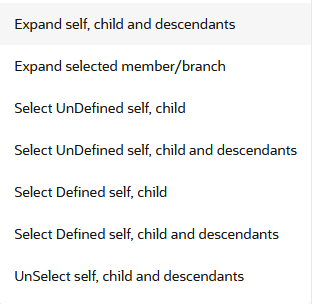5.3.2.2.2 Creating a Forecast Balance Rule
To create a new Forecast Balance rule, complete the following steps:
Figure 5-157 Create Forecast Balance Rule

- Click the Add on the Forecast Balances summary page to add a new rule.
- Enter the following Details.
Table 5-43 Create Forecast Balance Rule
Fields Description Name Enter the name of the Forecast Balance Rule. Description Enter the description of the Forecast Balance Rule. This is an optional field. Folder Select the Folder where the Forecast Balance Rule needs to be saved. Access Type Select the Access Type as Read-Only or Read/Write. MDBSS Folder Select the MDBSS folder MDBSS Hierarchy Select the MDBSS hierarchy Time Bucket Folder Select the Folder from which you want to apply Time Bucket Rule. Time Bucket Rule Select the time horizon/aggregation for rule. Assumptions that you define when creating a forecast balance are based on a specific modeling horizon, which is defined in the Time Buckets. Example
If you define a forecast balance based on a Time Bucket with a monthly modeling horizon, your results are calculated in monthly time periods.
If you redefine that same forecast balance, using a different time bucket with a weekly modeling horizon, your results are calculated in weekly time periods. If assumptions in your Forecast Balance are based on a modeling horizon that is different from the horizon defined in the active time bucket, inaccurate data will result. You should verify that date-sensitive rules are consistent with the active Time Bucket.
Currency Select the currency for Forecast Balance Note:
If any member is a currency in the MDBSS hierarchy (for example, INR) and selected currency is different (for example USD), then the member and its children nodes cannot be defined.
- Select the MDBSS node(s) from Assumption Browser. The Assumption Browser
has following two tabs: Member Tree and Search Results
- Member Tree: Use the Member Tree tab to view the hierarchical
structure and define rules by selecting the node members from the browser.
Select Node and click the menu icon next to it to view the available
options. Select Node and Click Menu icon next to it to view the available
options.
Figure 5-158 Member Tree

Status of node is also displayed in Member Tree section, for example Selected, and so on. To select member hierarchy, following options are available:
- Expand self, child and descendants: Allows to expand the selected node itself along with its child and descendants.
- Expand selected member/branch: Allows to expand the selected node
- Select UnSelect self, child: Allows to unselect the selected node itself along with its child
- Select UnSelect self, child and descendants: Allows to unselect the selected node itself along with its child and descendants.
- Select Defined self, child: Allows to select the selected node itself along with its child.
- Select Defined self, child and descendants: Allows to select the selected node itself along with its child and descendants.
- UnSelect self, child and descendants: Allows to unselect the selected node itself along with its child and descendants.
Use Show Numeric Code Values (Left) icon to view the code value left to the Node name.
Use Show Numeric Code Values (Right) icon to view the code value right to the Node name.
Here, you can perform the following tasks on the selected node(s):
- Add
- Edit
- View
- Delete
- Copy
- Search Results: You can also search the members based on the
filters. This section shows the searched node(s). To search a member, follow
these steps:
- Navigate to Assumption Browser section of the Rule Definition page.
- Enter the Member ID, Name, Status, or Is Leaf in Search
Criteria.
Figure 5-159 Search Criteria

- Click Search. The searched member(s) will be
displayed in Search Results section of Assumption
Browser
Figure 5-160 Searching Members

Here, you can perform the following tasks on the searched node(s):
- Add
- Edit
- View
- Delete
- Copy
Click Show Parentage icon to view the Parent-child Node level hierarchy details of selected Node.
Use Show Numeric Code Values (Left) icon to view the code value left to the Node name.
Use Show Numeric Code Values (Right) icon to view the code value right to the Node name.
- Member Tree: Use the Member Tree tab to view the hierarchical
structure and define rules by selecting the node members from the browser.
Select Node and click the menu icon next to it to view the available
options. Select Node and Click Menu icon next to it to view the available
options.
- Select Forecast Balance Method from Method drop-down.
- Select the predefined Rate Dependency Pattern from Rate Dependency Pattern drop-down. Else, click corresponding Action button to create new Rate Dependency Pattern, edit Rate Dependency Pattern, or view Rate Dependency Pattern.
- Click Add from Assumption Browser section.
- Click Save